Last Night on Earth boardgame, created by Jason C. Hill, takes you into the heart of horror movie action as players must either battle the shuffling, brain-munching zombies that have taken over the town or strategically surround the archetype survivors in a bid to turn them into the walking undead.
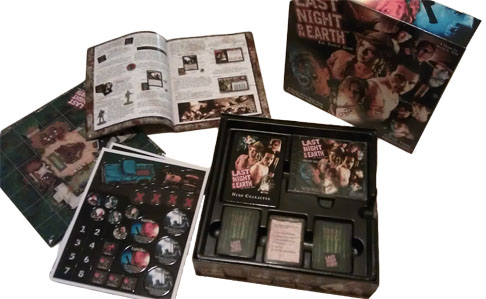
Last Night On Earth is a stunning looking board game, all packaged neatly in its horror movie-style designed, medium sized box that strangely weighs a ton! Quality is the key to this game and game-makers Flying Frog Productions certainly do not skimp on making Last Night on Earth a thoroughly enjoyable board game from as soon as you lift off the box lid.
Let’s take a look at the contents:
1x Full Colour Rule Book
1x Town Centre Game Board
6x L-Shaped Outer Boards
8x Unique Hero Character Figurines (Grey)
14x Zombie Figurines (7 Green, 7 Brown)
40x Card Hero Deck
40x Card Zombie Deck
20x Advanced Cards for Hero Deck
20x Advanced Cards for Zombie Deck
6x Reference Cards
8x Large Hero Character Sheets
5x Large Scene Scenario Cards
2x Full Colour Sheets of Die-Cut Counters
16x Dice
1 CD Soundtrack of Original Music
I normally scream murder when companies use cardboard for their counters but I cannot turn the air blue in Last Night on Earth‘s case because their contents are made from a super high quality glossy cardboard mix that is in fact the reason why the game box weighs so much. Glistening in the light and a joy to feel, the scenario and character cards are outstanding, using real life photos of actors in character for the roles of the heroes and zombies. A great amount of effort has gone into making this game and it should be acknowledged.

However, Flying Frog Productions don’t stop there, as with all their games they provide an original soundtrack to accompany their game and in Last Night On Earth‘s case, it’s a collection of spooky sounds indeed. The music isn’t so dramatic that it’ll put you off your gaming, instead it’s suitable background music to bring that extra frightening feel to the game. A nice touch, I thought.

Last Night On Earth board game is for 2 to 6 players ages 12+ and is one of those games that will benefit from having more than two players, though can be played by two adequately. A detailed, easy to understand, full colour 24-page instructional booklet, accompanied with helpful pictures, explains how to play the game though the learning curve is roughly an hour or so. Gameplay reference cards to aid players with the rules of a turn are included in the box and are vital for those new to the game.
Players will decide on who plays the hero characters and who plays the role of the zombies before the game officially starts. Who can play what depends on the amount of players there are though there should normally be a balance of or more Hero players than Zombies. In the case of a 2 player game like which we played, one player must play the heroes, the other zombies.
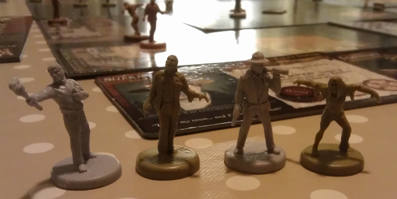
Both the zombies and the survivors are represented on the board as plastic figurines, much like the ones in ZOMBIES!!! The survivors are unique in appearance and sync up with their individual character cards which I’ll comment on a little later. The zombies too have unique poses, though they all serve the same purpose.
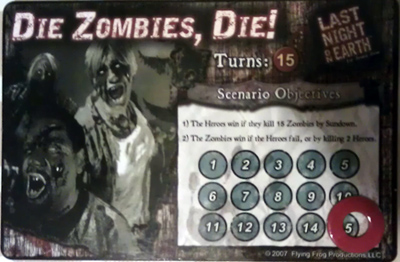
To start the Basic Game, which is aimed at beginners or those looking for a fast-paced game, the Die Zombies, Die! scenario card must be placed face up so all players can see it. This card details how many zombies must be beaten in order for the hero player to win the game.
![]()
The Sun Tracker must be popped out of it’s card and placed on the table. The Sun Tracker is used to track the number of Zombie turns, with the yellow ring counter starting at 15 and moving one space down each time the Zombie player begins their turn. Should the Sun Tracker reach 0 before the Hero player has collected 15 zombies, then the Zombie player wins the game. There’s a handy note against the number 15 to give you a hint for Die Zombies, Die! scenario when setting up future games, as well as the numbers for other scenarios.
With the Sun Tracker and Scenario in place for everyone to see, the gameplay board needs to be set. The square town centre board is placed in the centre of the table and 4 L-shaped boards are picked blindly at random then revealed and placed around the town centre tile to create a giant playing board.
The players must then shuffle the Hero and Zombie card decks (do not include the Advanced cards which are marked with a symbol in the bottom corner).
The Hero player must pick 4 Hero Character Sheets at random from the Hero Character sheet deck. No matter how many players are playing the Heroes, there should always be 4 Hero Characters in play in a game. So if only one player is playing the Hero side, they must select 4. If two players are Heroes, they must take 2 each.
I played the Heroes in our 2 player game, whereas my opponent played the zombies, thus I randomly took 4 character cards which were Sheriff Anderson, Johnny the Jock, Billy and Father Joseph.
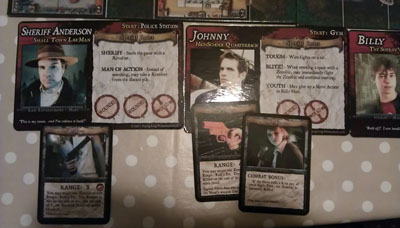
Along with the character cards, you must take the Grey Hero Character Figurines that match up with your cards. Read each character card to see where their Start: Location is and place them in any square within that building on the board. If the building doesn’t exist on the board, place the character figurine in the middle of the town centre square and receive 1 Hero Card drawn from the top of the Hero Deck as a bonus.
Hero Cards consist of Items and Events. Items must be assigned to the character in which you drew the card for, but events can be put to one side for you to use, as the player, on any of your characters. Many of the items are weapons, such as the flare gun or revolver, the latter of which is the starting out item for the Sheriff character. These items can be used to kill the zombies from a distance. Event cards can be used to change the outcome of certain instances, and in some case, can be kept in your hand after using without being discarded. This is usually when used with a certain character, such as the Faith card with Father Joseph.
Once all the Hero characters are on the board, the Zombie player must create their zombie pool. If there is one zombie player, like in our case, then all 14 zombies can be used within the game. The Zombie player rolls 2x dice and adds the numbers to calculate the total number of zombies to start the game with. These zombies are then placed evenly on the spawning pits, marked with a red X, on the board. There must be at least one zombie on each spawning pit before another can be added onto that particular spawning pit site.
Wound markers are popped out of their counter sheet and placed within easy reach of all players beside the board. These wound markers come in handy in the rounds when the Hero characters get injured from vicious zombie bites.

The game then commences with the Zombie player taking their turn first. They must draw up up to four Zombie cards from the deck and keep them secret from the Hero player. These cards can be used at any point seen strategically necessary during their turn or within a battle, unless it instructs to Play Immediately, which they must. The zombie player then rolls 2 dice and adds them together to see if they have permission to add more zombies into play at the end of their turn. If the total is higher than the amount of zombies currently in play, then they may add more zombies later, otherwise they cannot. The Zombie player must then move their zombies one space each, be it forwards, backwards, sidewards, diagonally and even through walls! Yes, the undead have ghost-like capabilities! The only rule that the player must follow is that their zombies must head towards a Hero character on the board, as the zombies would do in their natural environment, forever on the quest to satisfy their unsatiable hunger for juicy living brains.
Should the zombies be moved onto a square shared by a hero or vice-versa, then the two must battle. To fight, the players must roll their Fight Dice to determine the winner. The Hero player rolls 2 dice whereas the Zombie player rolls 1. The Hero player decides who should roll first. The players use their highest dice roll to decide who wins and should it be a draw, the Zombie player wins unless the particular Hero character sheet states otherwise. The Hero and Zombie cards in the players hand can be used at this time to aid the player to victory, though the Zombie player can only use one card per battle. If the Zombie wins, the Hero character must take a wound counter and place it on their character sheet. If the Hero player wins, the fight ends and both the hero character and zombie remain on the square, unaffected, and the game continues. Should the Hero win and have rolled doubles, the Zombie is defeated and killed, thus allowing the Hero player to move the counter on their Die Zombie, Die! scenario card up one place.
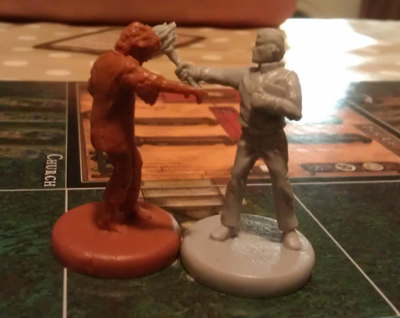
After all battles are resolved, the Zombie player may roll 1 dice to deduce how many new zombies may be placed onto the spawning pits, providing the player rolled a high enough number earlier on in their turn, otherwise the Zombie player’s turn ends. The dice number dictates how many zombies should be added to the game and they must be placed evenly on the spawning pits.
The end of the Zombie player’s turn signals the start of the Hero player’s turn. With 4 characters to play, the Hero player must go through a turn for each character seperately. By rolling a dice, the number equates to how many spaces the character figurine may move up to on the board. The Hero characters can move forwards, backwards, sideways and diagonally, but not through walls, and if they encounter a zombie they must battle it.
Alternatively, the player may decide not to move their character and instead ‘search’ for items. This can only be done if the character is within a building. To perform a ‘search’, simply take 1 card from the top of the hero deck. This signals the end of the search and the card is kept with the character (if it’s an item) or the player (if it’s an event).
After moving the character or searching, the player may exchange items with their character with any other hero character occupying the same square. If no other character occupies the square then the player can commence with any range attacks, using the weapon item cards accompanying the character in play.
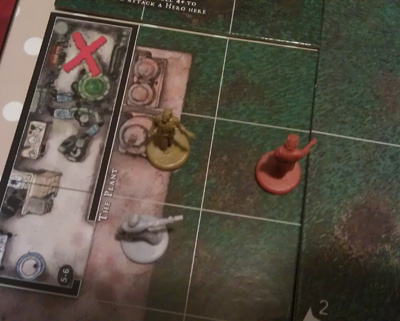
The weapon item cards have Range: listed on them and the character can make an attack on a zombie providing they are within range to the amount of spaces dictated on the weapon card. The weapon card instructs the player on how to win the ranged attack to either wound or kill the zombie opponent.
After the range attack, the hero must fight any zombies they share the square with, as detailed above in the Zombie players turn. Once this is complete, this signals the end of the hero character’s turn and the Hero player must repeat for their three other characters in play on the board.
Should a Hero character be killed or receive enough wounds to be killed, then that character is removed from the board and game.
Once all the Hero character’s turns have been completed by the Hero player, the ’round’ has ended and must commence again with the Zombie player. The Zombie player moves the sun tracker down one at the beginning of their turn, to signal the rounds, therefore in order for the Hero to win the Die Zombie, Die! scenario, they must kill 15 zombies within 15 rounds.
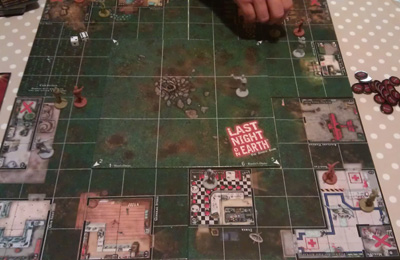
Final Verdict
I’m very pleased to say I managed to win the game as the Hero player, but only just! After taking a while to get the game started due to the slightly complex rules, we slowly got into the groove of gameplay. The instruction reference cards were a God send to start with, as we found the turns to contain many different motions to complete. About halfway through the game, we picked up momentum and managed to play without the aid of the reference cards and were able to use strategy to attempt to beat each other.
Whilst the gameplay was fun, it felt rather uneven at times. The zombie player had only one set of characters to move whereas I had 4 different ones to play as the Hero player. This made the game feel a little unbalanced as I felt I was hogging most of the gameplay and that the Hero role was more varied than the Zombie player’s. I would definitely recommend playing this with more than 2 players if possible to create a better balanced game, though a 2 player game was still enjoyable.
The Zombie player found their role interesting enough but had a slight niggle with one of the motions during the Zombie turn. The part in which the Zombie player must roll a dice in order to ‘confirm’ whether they would be allowed to add more zombies or not at the end of the turn felt unnecessary. The roll of the dice at the end of the turn could simply dictate whether more zombies could be added or not without the need of a prior roll.
As the game reached the midway point, the pressure was on and the competition aspect of the game heated up as I tried to kill off as many zombies as possible, with very few weapons. The Zombie player took great delight in thwarting my plans during battles to acquire more kills. When you realise there’s a set time to complete the game and win, this creates the best tension as panic takes other and strategy must provail, as well as luck.

Last Night on Earth isn’t a simple game to get into but once you’ve spent a couple of hours getting to grips with the rules, it’s a fairly easy enough game to play. The game has many other scenarios contained in the box to create a whole different game objective. One of these scenarios places the heroes in the town centre with a broken down truck that needs fuel. Gasoline cans are spread throughout the board but the infected undead are shuffling about the board and preventing the heroes from easy access to the cans. The goal is to bring all the cans back to the truck and to find the keys to start it in order to escape the outbreak. These extra scenarios, as well as the ability to create your own, opens up the game to a whole new level. The choices on offer mean you can play at least 5 different missions with the one game pack (rather than buying expansion packs), creating an ultimate boardgame which you’ll find hard to get bored with.
Last Night On Earth is a superb all-round board game which utilises typical zombie movie scenarios within the gameplay, offering plenty of fun gaming experiences to boardgame fans and zombie genre fans alike.
Last Night On Earth is available from Amazon




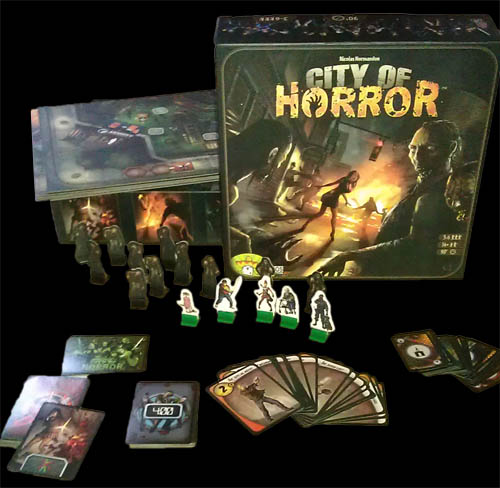

Be the first to comment